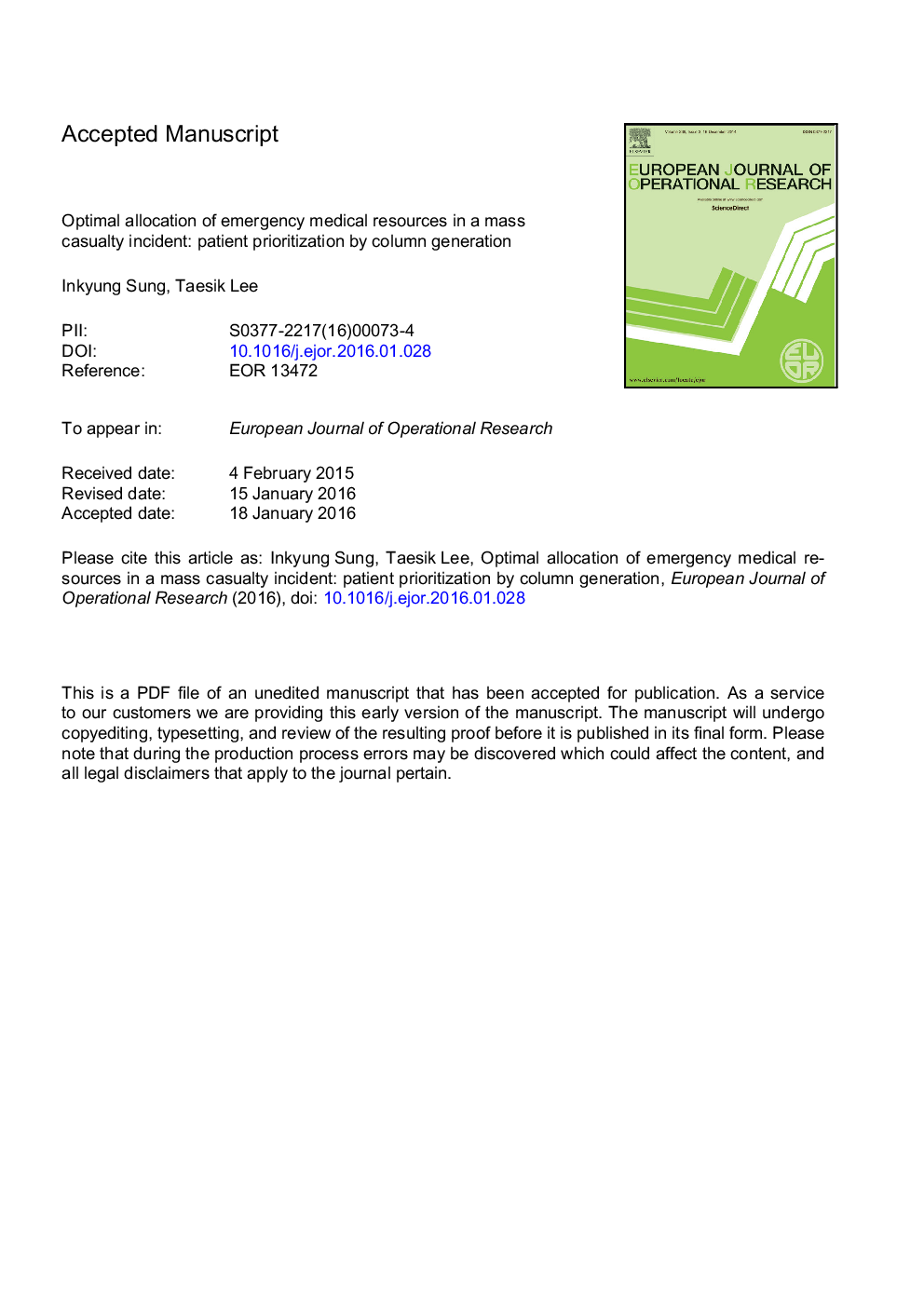| کد مقاله | کد نشریه | سال انتشار | مقاله انگلیسی | نسخه تمام متن |
|---|---|---|---|---|
| 6895740 | 1445980 | 2016 | 31 صفحه PDF | دانلود رایگان |
عنوان انگلیسی مقاله ISI
Optimal allocation of emergency medical resources in a mass casualty incident: Patient prioritization by column generation
ترجمه فارسی عنوان
تخصیص بهینه منابع پزشکی اضطراری در یک حادثه تلفات جمعی: اولویت بندی بیمار توسط تولید ستون
دانلود مقاله + سفارش ترجمه
دانلود مقاله ISI انگلیسی
رایگان برای ایرانیان
کلمات کلیدی
یا در حوادث فاجعه، حادثه تلفات جمعی، تریاژ، خدمات اورژانس پزشکی، نسل ستون،
ترجمه چکیده
حوادث عظیم تلفات موجب افزایش تقاضا برای خدمات پزشکی اورژانسی می شود و این امر اغلب می تواند ظرفیت پاسخ اضطراری را غرق کند. بنابراین، مهم است که منابع حیاتی پزشکی اورژانس را با توجه به اولویت بندی به حداکثر رساندن ظرفیت نجات، اهمیت دهیم. در یک سناریوی سنتی تریاژ، اولویت دریافت مراقبت تنها توسط حساسیت بیمار در زمان ارزیابی تعیین می شود. مطالعات اخیر نشان می دهد که تریاژ محدود کننده منابع در ارائه بهترین نتیجه به حداکثر تعداد بیماران موثر است. ما این مشکل را به عنوان یک مساله مسیریابی آمبولانس مدل سازی می کنیم و بیمارستان های سفارش و مقصد برای تخلیه بیمار را تعیین می کنیم. این به عنوان یک مشکل پارتیشن بندی مجموعه ای تشکیل شده است و ما یک رویکرد نسل ستون برای کارآمد بودن تعداد زیادی از برنامه های آمبولنی قابل اجرا را اعمال می کنیم. ما نشان می دهیم که الگوریتم پیشنهادی با یک روش ساخت ستون، مشکل را به نزدیک بودن بهینه در یک زمان محاسبه کم را حل می کند، و راه حل های حاصل از الگوریتم از تخصیص منابع اختصاص یافته به اولویت فزاینده بالاتر است.
موضوعات مرتبط
مهندسی و علوم پایه
مهندسی کامپیوتر
علوم کامپیوتر (عمومی)
چکیده انگلیسی
Mass casualty incidents create a surge in demand for emergency medical services, and this can often overwhelm the emergency response capacity. Thus, it is critically important to ration the emergency medical resources based on prioritization to maximize the lifesaving capacity. In a traditional triage scenario, the priority for receiving care is solely determined by a patient's criticality at the time of assessment. Recent studies show that a resource-constrained triage is more effective in providing the greatest good to the maximum number of patients. We model this problem as an ambulance routing problem, and determine the order and destination hospitals for patient evacuation. This is formulated as a set partitioning problem, and we apply a column generation approach to efficiently handle a large number of feasible ambulance schedules. We show that the proposed algorithm with a column generation approach solves the problem to near optimality within a short computation time, and the solutions derived by the algorithm outperform fixed-priority resource allocations.
ناشر
Database: Elsevier - ScienceDirect (ساینس دایرکت)
Journal: European Journal of Operational Research - Volume 252, Issue 2, 16 July 2016, Pages 623-634
Journal: European Journal of Operational Research - Volume 252, Issue 2, 16 July 2016, Pages 623-634
نویسندگان
Inkyung Sung, Taesik Lee,
